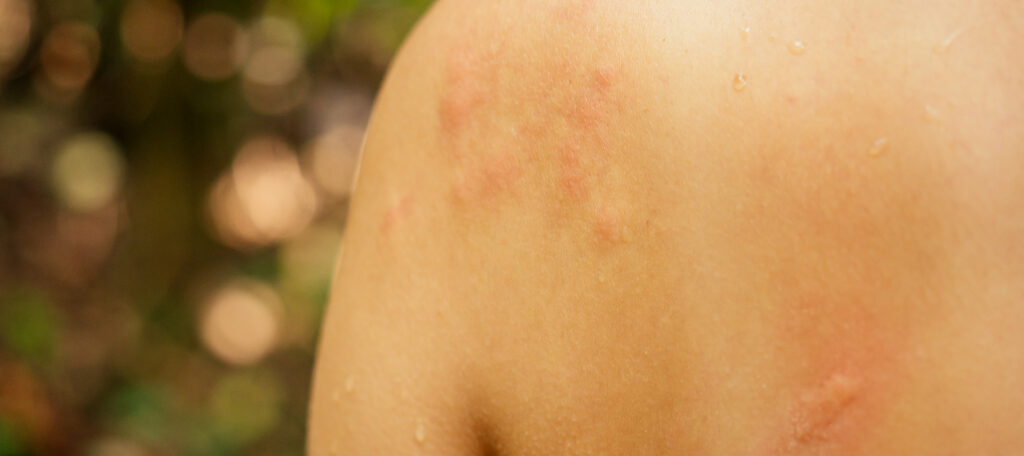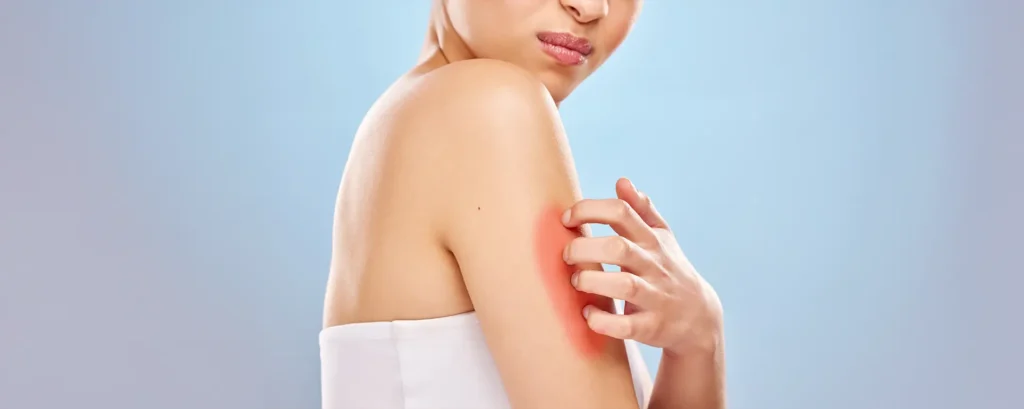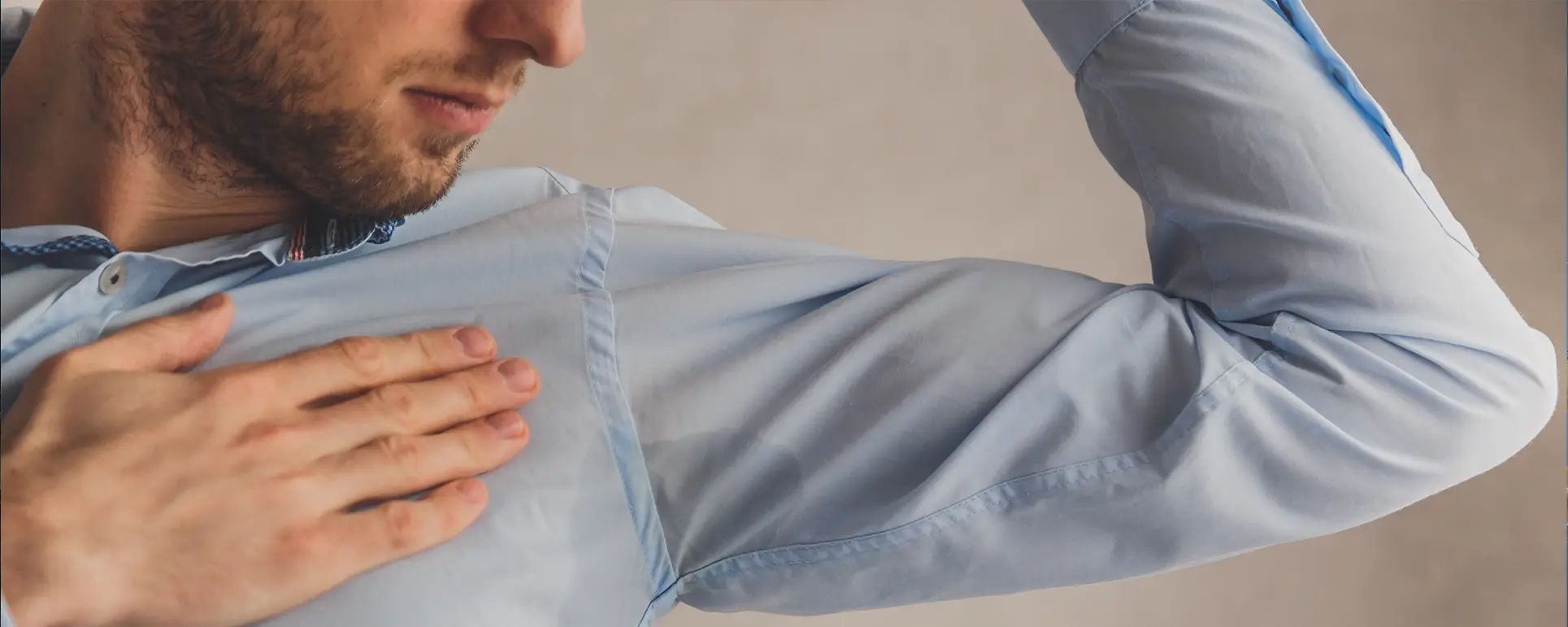It sounds almost unbelievable being allergic to your own sweat. But for some people, sweating triggers itching, redness, or even hives. You might notice your skin breaks out after exercise, hot weather, or stress. The reaction can be uncomfortable, embarrassing, and difficult to manage.
This condition isn’t your imagination. It’s known as cholinergic urticaria, a type of physical allergy where your body reacts to heat and sweat. It’s not technically an “allergy” to sweat itself, but rather an overreaction of your immune system to certain triggers associated with sweating.
In this guide, we’ll look at why this happens, what symptoms to look out for, how dermatologists diagnose sweat allergies, and the most effective treatments available.
What Is Cholinergic Urticaria?
Cholinergic urticaria (also called heat hives or sweat allergy) is a skin condition that causes small, itchy hives or red bumps to appear when your body temperature rises and you start sweating.
It’s a form of physical urticaria, meaning it’s triggered by physical stimuli in this case, heat, exercise, emotional stress, or even spicy food.
When you sweat, your body releases a chemical called acetylcholine, which activates the sweat glands. In people with cholinergic urticaria, this chemical also triggers the release of histamine and other inflammatory substances in the skin, leading to redness, swelling, and itching.
Can You Really Be Allergic to Your Own Sweat?

The term “sweat allergy” is somewhat misleading. You’re not allergic to sweat itself, since sweat is made of water, salt, and trace minerals. However, your immune system can react abnormally to the process of sweating or to specific components of sweat that interact with your skin.
For some people, it’s thought that the immune system mistakes sweat for a foreign irritant, releasing histamine in response. For others, the reaction might be linked to blocked sweat glands or hypersensitivity to heat rather than sweat itself.
So, while you’re not truly allergic to your own body fluid, your skin behaves as if you were.
Common Triggers That Cause Reactions
You might notice that certain situations consistently trigger your symptoms. Common culprits include:
- Exercise: Physical activity increases your body temperature and sweat production.
- Hot showers or baths: Sudden exposure to heat can set off itching or hives.
- Emotional stress or anxiety: Stress hormones increase heat and perspiration.
- Spicy foods: Can cause flushing and sweating, especially around the face and neck.
- Warm or humid weather: Makes sweating more frequent and intense.
- Tight clothing: Traps heat and moisture against your skin, worsening irritation.
In most cases, symptoms appear within minutes of sweating and fade after 30–60 minutes once your body cools down.
Symptoms of Sweat Allergy (Cholinergic Urticaria)

The condition varies in intensity, but the most common symptoms include:
- Small, itchy red bumps or hives (usually 1–3 mm wide).
- Burning or prickling sensation on the skin.
- Flushing or redness, especially on the face, chest, arms, and neck.
- Wheals raised, circular patches that can merge into larger swollen areas.
- Tingling or warmth before the rash appears.
In more severe cases, symptoms may include shortness of breath, dizziness, or swelling of the lips or eyes known as angioedema. If this occurs, you should seek medical help immediately.
How Long Do Symptoms Last?
Most episodes resolve within an hour after cooling down. However, in people with chronic or severe cholinergic urticaria, flare-ups may last longer and recur multiple times per week.
Over time, repeated reactions can make the skin more sensitive, leading to persistent itching even when no rash is visible.
Who Is Most Affected?
Cholinergic urticaria can affect anyone but is most common in:
- Young adults (especially men aged 15–35).
- People with existing allergies or eczema.
- Those with high-stress lifestyles.
In many cases, symptoms improve with age or treatment but for some, they can persist for years.
How Dermatologists Diagnose Sweat Allergy
Because cholinergic urticaria can look similar to other skin conditions, diagnosis should always be made by a qualified dermatologist.
During your appointment, your doctor may:
- Review your medical history including allergy symptoms, triggers, and frequency.
- Perform a physical examination checking your rash pattern and timing.
- Carry out a “sweat test” you may be asked to exercise, sit in a warm room, or take a hot bath to induce sweating while your skin is monitored.
- Conduct blood or skin tests to rule out other types of urticaria or allergic reactions.
At an Allergy Clinic in London, these tests are safely performed under medical supervision to accurately confirm whether your symptoms are caused by cholinergic urticaria or another condition.
Related Conditions to Rule Out
Some other skin issues can mimic sweat allergy symptoms:
- Heat rash (miliaria): Caused by blocked sweat glands, leading to tiny red spots or blisters.
- Contact dermatitis: Allergic reaction to products like deodorants or laundry detergents.
- Exercise-induced anaphylaxis: A rare but serious reaction to exercise or certain foods combined with physical exertion.
- Aquagenic urticaria: A rare condition triggered by contact with water (even non-sweat).
Accurate diagnosis ensures the right treatment approach.
Treatment Options for Cholinergic Urticaria
While there’s no permanent cure, several treatments can manage symptoms and prevent flare-ups. Your dermatologist will tailor the plan to your specific needs.
1. Antihistamines
These are usually the first line of treatment. They block the effects of histamine the chemical responsible for itching and swelling.
Common examples include:
- Cetirizine (Zyrtec)
- Loratadine (Clarityn)
- Fexofenadine (Telfast)
For severe or chronic cases, your doctor may recommend taking them daily rather than just during flare-ups.
2. Anticholinergic Medications
These reduce your body’s response to acetylcholine, the substance that triggers sweating and histamine release. However, they must be prescribed carefully due to possible side effects like dry mouth or blurred vision.
3. Beta-Blockers
Beta-blockers such as propranolol may help in some patients by reducing adrenaline and stress-related flare-ups.
4. Desensitisation Therapy
Some dermatologists use a gradual approach called sweat desensitisation therapy. It involves regular, controlled exposure to heat or exercise to train your body to tolerate sweat without reacting.
This approach takes time and consistency but can be effective for some patients.
5. Immunotherapy and Biologics
In more severe cases, medications like omalizumab (Xolair) a biologic injection that targets IgE antibodies have shown promise in reducing chronic urticaria symptoms.
This is typically reserved for patients who don’t respond to standard antihistamines.
6. Lifestyle and Skincare Adjustments
Managing triggers can make a huge difference.
- Shower immediately after sweating to prevent irritation.
- Wear loose, breathable clothing to allow heat to escape.
- Avoid sudden temperature changes, like going from a cold room to a hot shower.
- Stay cool during workouts use fans, hydration, and lighter fabrics.
- Reduce stress through yoga, breathing exercises, or mindfulness.
These small habits can significantly reduce flare-ups over time.
Preventing Sweat Allergy Flare-Ups
Prevention is about understanding your triggers and taking proactive steps:
- Plan exercise strategically. Work out in cooler environments, early morning or late evening.
- Use gentle, fragrance-free soaps. Harsh chemicals can worsen irritation.
- Keep your skin barrier strong. Use moisturisers with ceramides or glycerin daily.
- Avoid tight sportswear. Choose breathable cotton or moisture-wicking fabrics.
- Stay hydrated. Dehydration increases heat sensitivity and discomfort.
When to Seek Medical Help
You should consult a dermatologist if:
- Your rashes appear frequently or without warning.
- The itching disrupts sleep or daily activities.
- Over-the-counter antihistamines don’t work.
- You experience swelling of the lips, eyes, or throat.
These could indicate a more severe form of urticaria that needs prescription medication or further testing at an Allergy Clinic in London.
Living with Cholinergic Urticaria
It’s normal to feel frustrated when something as natural as sweating triggers discomfort. However, with proper diagnosis and treatment, most people learn to manage symptoms effectively.
Regular follow-ups with your dermatologist help monitor progress and adjust medications if needed. Over time, many patients notice their reactions become milder or less frequent.
Can Cholinergic Urticaria Go Away on Its Own?
Yes in some cases, it can. Studies show that symptoms may spontaneously improve or disappear after several years. However, others may experience periodic relapses.
Maintaining a healthy lifestyle, avoiding known triggers, and following your dermatologist’s plan give you the best chance for long-term relief.
Myths About Sweat Allergies
Many misconceptions exist about sweat allergies, so it’s important to separate myth from reality. Some people believe that you can’t be allergic to sweat, but while it’s not a classic allergy, your immune system can overreact to sweating. Another common myth is that it only happens to unfit people; fitness has nothing to do with it even athletes can experience cholinergic urticaria. Some think it is contagious, but sweat allergy is not infectious and cannot spread to others. Finally, the idea that you should just avoid sweating altogether is unrealistic. The goal is to manage triggers, not completely prevent sweating. Understanding these truths can help you manage the condition without unnecessary worry.
Emotional Impact and Support
Frequent flare-ups can affect confidence and social life, especially if they occur in visible areas like the face or neck. Some people feel anxious about exercise, social gatherings, or even warm weather.
If you find yourself avoiding activities you once enjoyed, talk to your dermatologist. Managing the physical symptoms often helps reduce emotional stress too.
You might also benefit from support groups or online communities where others share similar experiences.
How a Specialist Can Help
If you suspect you have a sweat allergy or chronic heat rash, don’t try to diagnose it yourself. The symptoms can overlap with other conditions, and effective treatment depends on the right diagnosis.
At our Allergy Clinic in London, specialists can help you:
- Identify the exact cause of your reactions.
- Rule out other types of urticaria.
- Prescribe safe and effective treatments.
- Provide long-term management plans tailored to your lifestyle.
Professional guidance makes it easier to regain control over your symptoms and get back to normal activities without fear of flare-ups.
FAQs:
1. Can I really be allergic to my own sweat?
It might sound strange, but yes, some people experience what’s called cholinergic urticaria, often referred to as a sweat allergy. It isn’t a true allergy to sweat itself, since sweat is mostly water and salts, but your immune system reacts abnormally during the process of sweating. Certain chemicals released in your skin, like histamine, trigger redness, itching, and hives. Essentially, your body behaves as if it’s reacting to a foreign substance, even though it’s producing sweat naturally.
2. What are the main signs that I might have a sweat allergy?
People with cholinergic urticaria often notice small, itchy red bumps or hives appear shortly after sweating. The skin may feel prickly or burning, and redness or flushing commonly shows up on the face, neck, chest, and arms. In more severe episodes, swelling of the lips or eyes, dizziness, or difficulty breathing can occur, which requires immediate medical attention. Most mild reactions subside within 30 to 60 minutes once your body cools down.
3. Why do some situations trigger these reactions more than others?
Sweat-induced reactions are often linked to anything that raises your body temperature. Physical exercise, hot showers, spicy foods, or emotional stress can all trigger symptoms. Warm or humid weather and tight clothing can worsen the reaction by trapping heat and moisture on the skin. Essentially, anything that stimulates sweating or increases heat in the body can act as a trigger for those prone to this condition.
4. How is cholinergic urticaria diagnosed?
A dermatologist can make an accurate diagnosis by reviewing your medical history, asking about symptom patterns, and performing a physical examination. Sometimes, a “sweat test” is used, where you might exercise, sit in a warm environment, or take a hot bath under supervision to see if symptoms appear. Additional blood or skin tests can help rule out other types of urticaria or allergic reactions, ensuring that your treatment plan targets the right condition.
5. Are there treatments that can completely cure sweat allergies?
Currently, there’s no permanent cure for cholinergic urticaria. However, symptoms can often be managed effectively with a combination of antihistamines, anticholinergic medications, beta-blockers, desensitisation therapy, and, in severe cases, biologics like omalizumab. The key is to work with a dermatologist who can tailor treatment based on the severity and frequency of your flare-ups.
6. Can lifestyle changes make a difference in managing this condition?
Yes, practical adjustments can significantly reduce flare-ups. Showering promptly after sweating, wearing loose and breathable clothing, avoiding sudden temperature changes, and staying hydrated are all helpful. Stress management through yoga, meditation, or deep-breathing exercises can also reduce the frequency of reactions, as stress hormones can trigger sweating. These habits complement medical treatment and improve overall skin comfort.
7. Is cholinergic urticaria more common in certain age groups or types of people?
This condition tends to affect young adults, particularly men aged 15 to 35, but it can occur in anyone. People with a history of allergies, eczema, or high-stress lifestyles are slightly more susceptible. While some individuals may see improvement with age, others may experience chronic flare-ups that persist for years.
8. Can sweat allergies go away on their own?
In some cases, symptoms do improve or even disappear over time, especially with consistent management and avoidance of triggers. However, many people experience periodic flare-ups even after long periods of remission. Regular dermatology follow-ups help track progress and adjust treatment as necessary.
9. Are there any misconceptions about sweat allergies I should be aware of?
Several myths exist. One common misconception is that only unfit people are affected, but fitness level has no bearing; even athletes can develop cholinergic urticaria. Another myth is that it’s contagious it is not. Some people believe that avoiding all sweating is the solution, which is unrealistic. The goal is to manage triggers rather than eliminate sweating entirely. Understanding these myths can help you cope without unnecessary stress or fear.
10. When should I seek professional help for a sweat allergy?
You should see a dermatologist if your rashes appear frequently, interfere with daily life, or do not respond to over-the-counter antihistamines. Immediate medical attention is necessary if you experience swelling of the lips, eyes, or throat, or if shortness of breath occurs. Consulting a specialist ensures that you receive a proper diagnosis, rule out other conditions, and follow a safe and effective treatment plan tailored to your needs.
Final Thoughts: Can You Be Allergic to Sweat?
Cholinergic urticaria, often described as a sweat allergy, can be frustrating and unpredictable. While it’s not a true allergy to sweat itself, the reactions it causes are real and can affect daily life. Understanding your triggers, following dermatologist-recommended treatments, and making simple lifestyle adjustments can make a significant difference in managing symptoms.
If you experience frequent flare-ups or suspect a sweat-related allergy, consulting a specialist is the best step. You can get in touch with us to book a consultation with our allergy clinic in London, where dermatologists can accurately diagnose your condition, rule out similar skin issues, and create a personalised management plan. Taking this step can help you regain confidence, manage symptoms effectively, and return to daily activities without fear of flare-ups.
References:
1. Godse, K., Farooqui, S., Nadkarni, N., & Patil, S. (2013). Prevalence of cholinergic urticaria in Indian adults. Indian Dermatology Online Journal, 4(1), 22–24. Available at: https://journals.lww.com/idoj/_layouts/15/oaks.journals/downloadpdf.aspx?an=01630814-201304010-00019
2. Fukunaga, A., & Sato, M. (2022). Cholinergic urticaria: Subtype classification and clinical features. Journal of Dermatology, 49(6), 507–514. Available at: https://pubmed.ncbi.nlm.nih.gov/36107396/
3. Shurmelova, I., & Makarova, A. (2025). Skin reaction patterns in cholinergic urticaria. Australasian Journal of Dermatology, 66(1), 1–5. Available at: https://www.sciencedirect.com/science/article/pii/S1323893024000856
4. Fukunaga, A., et al. (2022). Cholinergic Urticaria: Subtype Classification and Clinical Presentation. Frontiers in Medicine, 9, 947640. https://pmc.ncbi.nlm.nih.gov/articles/PMC9476404/
5. Sirufo, M. M., et al. (2022). Cholinergic Urticaria, an Effective and Safe “Off Label” Use of Dupilumab. Clinical, Cosmetic and Investigational Dermatology, 15, 1–6. https://pmc.ncbi.nlm.nih.gov/articles/PMC8863185/
